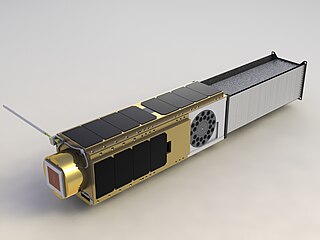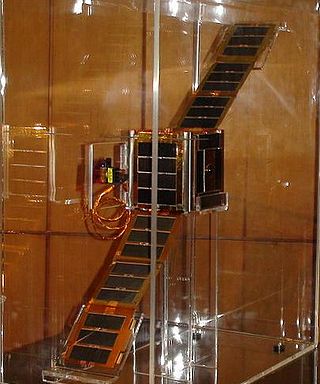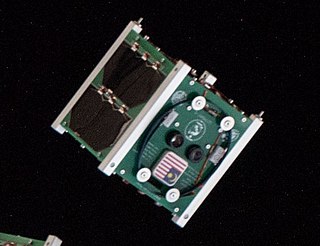
A CubeSat is a class of miniaturized satellite with a form factor of 10 cm (3.9 in) cubes. CubeSats have a mass of no more than 2 kg (4.4 lb) per unit, and often use commercial off-the-shelf (COTS) components for their electronics and structure. CubeSats are put into orbit by deployers on the International Space Station, or launched as secondary payloads on a launch vehicle. As of August 2021, more than 1,600 CubeSats have been launched.

A small satellite, miniaturized satellite, or smallsat is a satellite of low mass and size, usually under 1,200 kg (2,600 lb). While all such satellites can be referred to as "small", different classifications are used to categorize them based on mass. Satellites can be built small to reduce the large economic cost of launch vehicles and the costs associated with construction. Miniature satellites, especially in large numbers, may be more useful than fewer, larger ones for some purposes – for example, gathering of scientific data and radio relay. Technical challenges in the construction of small satellites may include the lack of sufficient power storage or of room for a propulsion system.

An electric sail is a proposed form of spacecraft propulsion using the dynamic pressure of the solar wind as a source of thrust. It creates a "virtual" sail by using small wires to form an electric field that deflects solar wind protons and extracts their momentum. The idea was first conceptualised by Pekka Janhunen in 2006 at the Finnish Meteorological Institute.
The University Nanosat Program is a satellite design and fabrication competition for universities. It is jointly administered by the Air Force Office of Scientific Research (AFOSR), the Air Force Research Laboratory (AFRL), the American Institute of Aeronautics and Astronautics (AIAA), the Space Development and Test Wing and the AFRL Space Vehicles Directorate's Spacecraft Technology division. NASA's Goddard Space Flight Center was involved from the program inception through Nanosat-3.

The O/OREOS is a NASA automated CubeSat nanosatellite laboratory approximately the size of a loaf of bread that contains two separate astrobiology experiments on board. Developed by the Small Spacecraft Division at NASA Ames Research Center, the spacecraft was successfully launched as a secondary payload on STP-S26 led by the Space Test Program of the United States Air Force on a Minotaur IV launch vehicle from Kodiak Island, Alaska on 20 November 2010, at 01:25:00 UTC.

LightSail is a project to demonstrate controlled solar sailing within low Earth orbit using a CubeSat. The project was developed by The Planetary Society, a global non-profit organization devoted to space exploration. It consists of two spacecraft — LightSail 1 and LightSail 2. LightSail 1 was an engineering demonstration mission designed to test its new sail deployment method in space, it did not perform solar sailing. LightSail 2 was a fully functional spacecraft intended to demonstrate true solar sailing and incorporated the lessons learned from LightSail 1. LightSail is a follow-on project to Cosmos 1 — a solar-sail spacecraft designed by The Planetary Society in the early 2000s, which was destroyed during a launch failure in 2005.

SARAL is a cooperative altimetry technology mission of Indian Space Research Organisation (ISRO) and Centre National d'Études Spatiales (CNES). SARAL performs altimetric measurements designed to study ocean circulation and sea surface elevation.

NEE-01 Pegaso is an Ecuadorian technology demonstration satellite, and Ecuador's first satellite launched to space. Built by the Ecuadorian Civilian Space Agency (EXA), it is a nanosatellite of the single-unit CubeSat class. The spacecraft's instruments include a dual visible and infrared camera which allows the spacecraft to take pictures and transmit live video from space.

RAX-2 is a CubeSat satellite built as a collaboration between SRI International and students at the University of Michigan College of Engineering. It is the second spacecraft in the RAX mission. The RAX-1 mission ended after approximately two months of operation due to a gradual degradation of the solar panels that ultimately resulted in a loss of power. RAX team members applied the lessons learned from RAX-1 to the design of a second flight unit, RAX-2, which performs the same mission concept of RAX-1 with improved bus performance and additional operational modes. Science measurements are enhanced through interactive experiments with high power ionospheric heaters where FAI will be generated on demand.

ESTCube-1 is the first Estonian satellite and first satellite in the world to attempt to use an electric solar wind sail (E-sail). It was launched on 7 May 2013 aboard Vega VV02 carrier rocket and successfully deployed into orbit. The CubeSat standard for nanosatellites was followed during the engineering of ESTCube-1, resulting in a 10×10×11.35 cm cube, with a volume of 1 liter and a mass of 1.048 kg.

PhoneSat is an ongoing NASA project of building nanosatellites using unmodified consumer-grade off-the-shelf smartphones and Arduino platform and launching them into Low Earth Orbit. This project is part of NASA's Small Spacecraft Technology Program and was started in 2009 at NASA Ames Research Center.

The Centre Spatial Universitaire (CSU) Montpellier-Nîmes is a division of the University of Montpellier. Its purpose is to educate students in space sciences through the design, production and testing of nanosatellites. The CSU was created to consolidate nanosatellite activities that were initiated in 2006 by the RADIAC team of the Institut d'Electronique et des Systèmes, a research institute also affiliated with the university.

GhanaSat-1 was the first Ghanaian nanosatellite to be launched into space. It was designed and built in two years in conjunction with the Kyushu Institute of Technology Birds-1 program, which has the goal of helping countries build their first satellite.

Mazaalai was a Mongolian nanosatellite CubeSat that was launched into space on 3 June 2017 as part of the SpaceX CRS-11 mission.

Birds-1 was the first iteration of a multinational program called the Joint Global Multi-Nations Birds Satellite project, or Birds project, to help countries build their first satellite. The Japanese Kyushu Institute of Technology (KIT) supported the design and fabrication of the satellites. The constellation was launched by a Falcon 9 rocket to the International Space Station on 3 June 2017, as part of CRS-11, where it was released from the Kibō module into space. Japan, Ghana, Mongolia, Nigeria, and Bangladesh participated in the Birds-1 program, all building identical satellites for the constellation.
CubeSail is a proposed nanosatellite project by the Surrey Space Centre (SSC) in England. The spacecraft is to be a 3U CubeSat propelled by a 25 m²solar sail. The project is financed and technically supported by aerospace manufacturers Astrium and Surrey Satellite Technology.
UBAKUSAT was a Turkish nanosatellite that was developed by Istanbul Technical University. It was launched into space on board a Falcon-9 rocket in April 2018 and was deployed into its orbit from the International Space Station in May 2018. It was built as a technology demonstration and earth observation satellite to provide voice communications for amateur radio stations around the world. It carried an experimental card, TAMSAT Simplesat, which allowed scientists to test its accuracy of measuring radiation from space. It was the fifth satellite to be built by students of Istanbul Technical University.

Maya-1 was a Filipino nanosatellite. It was developed under the Philippine Scientific Earth Observation Microsatellite program (PHL-Microsat) and was jointly implemented by the University of the Philippines and the Department of Science and Technology as part of the Kyushu Institute of Technology-led multinational second Joint Global Multi-nations Birds Satellite (Birds-2). Maya-1 was the first nanosatellite of the Philippines.

UiTMSAT-1 was a Malaysian nanosatellite, built primarily by Universiti Teknologi MARA (UiTM) as part of the multi-nation Birds-2 project. The 1U CubeSat was launched into space on 29 June 2018 and deployed from the International Space Station (ISS) on 10 August 2018.
















